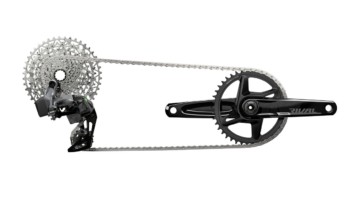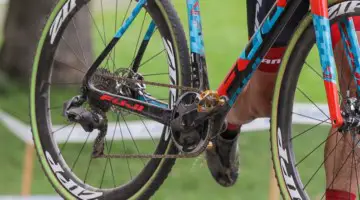SRAM Force CX1 Rear Derailleur: XX1 Technology, With Exact Actuation Cable Pull
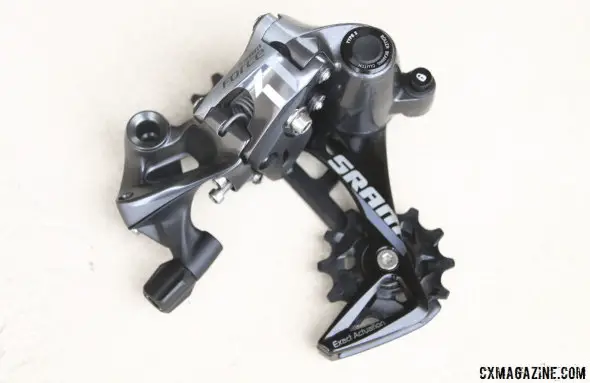
SRAM’s new Force CX1 single chainring cyclocross drivetrain rear derailleur is completely different than the standard Force rear derailleur, with a Type 2 Roller Bearing Clutch and X-Horizon movement. It’s also about 70g heavier than a Force WiFLi equivalent. © Cyclocross Magazine
SRAM took all of the technologies that have made the XX1 rear derailleur successful with single ring setups and applied them to a Force-level rear derailleur. This includes:
-
- The Type 2 Roller Bearing Clutch system that minimizes chain slap
- The Cage Lock button that locks the pulley cage in place for easy wheel removal and chain installation
- X-SYNC sealed bearing 12-tooth wide/narrow pulleys for chain retention
- The X-Horizon straight parallelogram design that allows the derailleur only to move along the horizontal axis
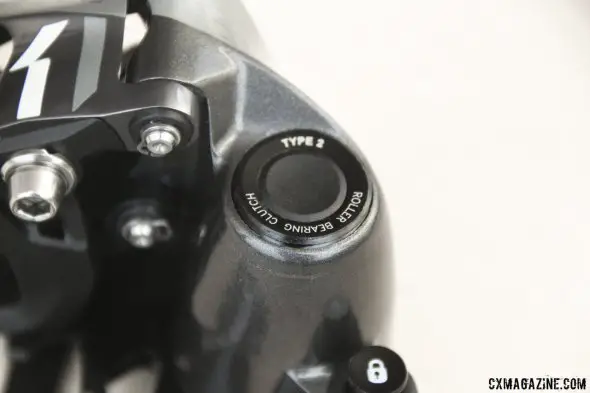
SRAM’s new Force CX1 rear derailleur adds SRAM’s Type 2 Roller Bearing Clutch to keep chain tension even and reduce chances of a derailled chain. © Cyclocross Magazine
The X-Horizon straight parallelogram is one key technology that SRAM emphasizes is critical for reliable single ring setups. While some racers have had success mixing wide/narrow rings from Wolf Tooth with SRAM Type 2 10-speed mountain bike derailleurs, SRAM cautions that using its slant parallelogram derailleurs over the X-Horizon CX1 rear derailleur increases the risk of ghost-shifting, since the pulley cage can move laterally across the cassette with large (vertical) bumps when using a slant parallelogram design. Suntour invented the slant parallelogram design 50 years ago (see this good explanatory video) and dramatically improved shifting and revolutionized rear derailleurs in the process, but in bumpy conditions, SRAM finds the design prone to ghost shifting.
Why not just use the XX1 or X01 rear derailleurs? There’s three reasons to not use these (more expensive) options:
-
- The 11-speed SRAM XX1 and X01 mountain bike rear derailleurs use X-Actuation, a different cable pull than the Exact Actuation of SRAM’s 11-speed road and 10-speed road and mountain bike shifters and derailleurs (although the 10-speed X01 DH rear derailleur should work).
- The mountain bike derailleurs work with 42t rear cogs, a larger capacity than necessary for cyclocross.
- The mountain rear derailleurs lack barrel adjusters for cable tension adjustment.
The $235 Force CX1 rear derailleur will actually come in two cage lengths, a short and medium cage. SRAM is strongly pushing the medium cage option, as it allows use of 11-32t cassettes, while the short cage is only compatible with a maximum 28th large cog.
The upside of the CX1 rear derailleur pulley cage and X-Horizon design is that you size the chain based on the smallest cog size. Have a hilly race or adventure ride planned? Slap on a bigger cassette and you’re ready. No chain lengthening needed.
We chased after dual suspension mountain bikers down some rutted, rocky descents and finished without dropped chains or ghost shifts, leaving us impressed with our first in-the-field tests. Granted it wasn’t sloppy or muddy, but the mountain bike terrain certainly helped us evaluate the Type 2 roller bearing clutch, X-SYNC and X-Horizon’s effectiveness in keeping our chain on regardless of bumps or shifting, and while several mountain bikers broke chains on our group ride, we were left rolling without incident—a successful first test.
Force CX1 Levers: DoubleTap Without the Left Guts
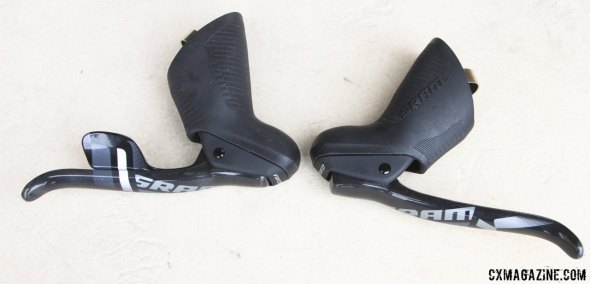
SRAM’s new Force CX1 left brake lever pairs with a right Force 22 lever. Both are mechanical cable pull levers. © Cyclocross Magazine
The last component of the Force CX1 cyclocross component group is the CX1 levers, which really are just a Force DoubleTap levers, with the left shift mechanism removed. The right 11-speed lever still keeps the Force branding, while the left lever gets the CX1 logo treatment and saves 40g due to the DoubleTap shift lever and internal mechanism being stripped away. The left lever will set you back $113.
Read on to see the full pricing and all our photo galleries of the different components, and stay tuned to read our complete first ride impressions.
























